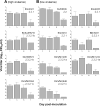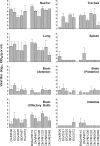Enhanced virulence of clade 2.3.2.1 highly pathogenic avian influenza A H5N1 viruses in ferrets
- PMID: 28038412
- PMCID: PMC5733775
- DOI: 10.1016/j.virol.2016.12.024
Enhanced virulence of clade 2.3.2.1 highly pathogenic avian influenza A H5N1 viruses in ferrets
Abstract
Sporadic avian to human transmission of highly pathogenic avian influenza (HPAI) A(H5N1) viruses necessitates the analysis of currently circulating and evolving clades to assess their potential risk. Following the spread and sustained circulation of clade 2 viruses across multiple continents, numerous subclades and genotypes have been described. To better understand the pathogenesis associated with the continued diversification of clade 2A(H5N1) influenza viruses, we investigated the relative virulence of eleven human and poultry isolates collected from 2006 to 2013 by determining their ability to cause disease in the ferret model. Numerous clade 2 viruses, including a clade 2.2 avian isolate, a 2.2.2.1 human isolate, and two 2.2.1 human isolates, were found to be of low virulence in the ferret model, though lethality was detected following infection with one 2.2.1 human isolate. In contrast, three of six clade 2.3.2.1 avian isolates tested led to severe disease and death among infected ferrets. Clade 2.3.2.1b and 2.3.2.1c isolates, but not 2.3.2.1a isolates, were associated with ferret lethality. All A(H5N1) viruses replicated efficiently in the respiratory tract of ferrets regardless of their virulence and lethality. However, lethal isolates were characterized by systemic viral dissemination, including detection in the brain and enhanced histopathology in lung tissues. The finding of disparate virulence phenotypes between clade 2A(H5N1) viruses, notably differences between subclades of 2.3.2.1 viruses, suggests there are distinct molecular determinants present within the established subclades, the identification of which will assist in molecular-based surveillance and public health efforts against A(H5N1) viruses.
Keywords: Ferrets; Influenza H5N1; Pathogenesis.
Published by Elsevier Inc.
Figures



Similar articles
-
Continued Evolution of H5Nx Avian Influenza Viruses in Bangladeshi Live Poultry Markets: Pathogenic Potential in Poultry and Mammalian Models.J Virol. 2020 Nov 9;94(23):e01141-20. doi: 10.1128/JVI.01141-20. Print 2020 Nov 9. J Virol. 2020. PMID: 32907981 Free PMC article.
-
Genetic characterization and pathogenicity assessment of highly pathogenic H5N1 avian influenza viruses isolated from migratory wild birds in 2011, South Korea.Virus Res. 2011 Sep;160(1-2):305-15. doi: 10.1016/j.virusres.2011.07.003. Epub 2011 Jul 12. Virus Res. 2011. PMID: 21782862
-
Highly pathogenic avian influenza A(H5N1) virus of clade 2.3.4.4b isolated from a human case in Chile causes fatal disease and transmits between co-housed ferrets.Emerg Microbes Infect. 2024 Dec;13(1):2332667. doi: 10.1080/22221751.2024.2332667. Epub 2024 Jun 13. Emerg Microbes Infect. 2024. PMID: 38494746 Free PMC article.
-
An Update on Highly Pathogenic Avian Influenza A(H5N1) Virus, Clade 2.3.4.4b.J Infect Dis. 2024 Sep 23;230(3):533-542. doi: 10.1093/infdis/jiae379. J Infect Dis. 2024. PMID: 39283944 Review.
-
The genetics of highly pathogenic avian influenza viruses of subtype H5 in Germany, 2006-2020.Transbound Emerg Dis. 2021 May;68(3):1136-1150. doi: 10.1111/tbed.13843. Epub 2020 Sep 29. Transbound Emerg Dis. 2021. PMID: 32964686 Review.
Cited by
-
The phylogenomics of evolving virus virulence.Nat Rev Genet. 2018 Dec;19(12):756-769. doi: 10.1038/s41576-018-0055-5. Nat Rev Genet. 2018. PMID: 30305704 Free PMC article. Review.
-
Sowing the Seeds of a Pandemic? Mammalian Pathogenicity and Transmissibility of H1 Variant Influenza Viruses from the Swine Reservoir.Trop Med Infect Dis. 2019 Feb 27;4(1):41. doi: 10.3390/tropicalmed4010041. Trop Med Infect Dis. 2019. PMID: 30818793 Free PMC article. Review.
-
Exploring associations between viral titer measurements and disease outcomes in ferrets inoculated with 125 contemporary influenza A viruses.J Virol. 2024 Feb 20;98(2):e0166123. doi: 10.1128/jvi.01661-23. Epub 2024 Jan 19. J Virol. 2024. PMID: 38240592 Free PMC article.
-
A Guide for the Use of the Ferret Model for Influenza Virus Infection.Am J Pathol. 2020 Jan;190(1):11-24. doi: 10.1016/j.ajpath.2019.09.017. Epub 2019 Oct 23. Am J Pathol. 2020. PMID: 31654637 Free PMC article. Review.
-
Utility of Human In Vitro Data in Risk Assessments of Influenza A Virus Using the Ferret Model.J Virol. 2023 Jan 31;97(1):e0153622. doi: 10.1128/jvi.01536-22. Epub 2023 Jan 5. J Virol. 2023. PMID: 36602361 Free PMC article.
References
-
- Abdel-Ghafar AN, Chotpitayasunondh T, Gao Z, Hayden FG, Nguyen DH, de Jong MD, Naghdaliyev A, Peiris JS, Shindo N, Soeroso S, Uyeki TM. Update on avian influenza A A(H5N1) virus infection in humans. N. Engl. J. Med. 2008;358:261–273. - PubMed
-
- CDC. A(H5N1) Genetic Changes Inventory: A Tool for International Surveillance. CDC; Atlanta: 2012. A(H5N1) Genetic Changes Inventory: a Tool for International Surveillance.
MeSH terms
Grants and funding
LinkOut - more resources
Full Text Sources
Other Literature Sources
Medical

